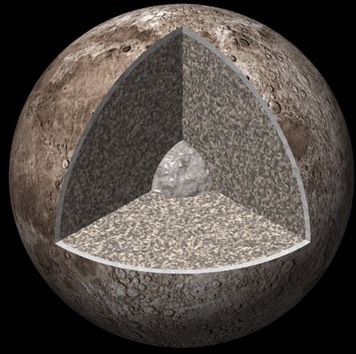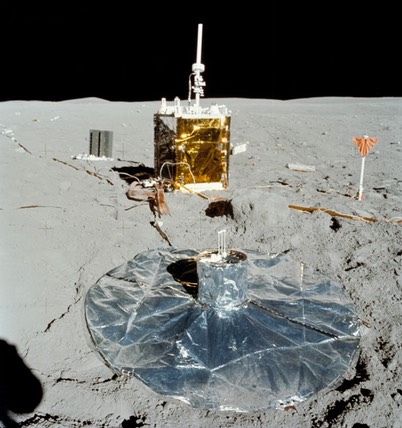
Cutway of the lunar interior. The lunar core is very small, approximately 300 km radius.

The lunar crust contains essential information about the formation and evolution of the Moon. Recent geophysical investigations find evidence for a relatively thin (28-45 km) crust beneath the major mare basins, suggesting impacts have played a significant role in the thermal and chemical evolution of the lunar crust. Seismological information on crustal thickness is provided by the Apollo Passive Seismic Experiment (APSE), a four station seismic array in operation on the Moon over the period of 1969-1977. The APSE recorded over 13,000 moonquakes, including approximately 1700 meteoroid impacts. The APSE dataset has proved to be an invaluable resource for understanding lunar internal structure, however only a small subset of moonquakes are located well enough for routine use in studying lunar crustal structure.
Seismic model of the lunar megaregolith and intepreted geological structure at depth. The megaregolith is the result of billions of years of impacts hitting the lunar crust.
Our group is investigating the lunar interior using a combination of seismic and gravity datasets. GRAIL high-precision data are particularly sensitive to the depth extent of porosity within the lunar crust. From modeling, we find that that the crustal density may vary widely from surface to deep crust by up to 500 kg/m3 satisfying the GRAIL observation of high-resolution gravity in conjunction with LOLA topography data. Our models infer the surface density of megaregolith should be ~2400 kg/m3, with an initial porosity of 10-20%, consistent with measurements of lunar samples and meteorites. We are finding that compacted anorthositic materials suggests this porosity extends 10-20 km into the lunar crust.
Additionally we are studying the nature of scattering in the lunar crust through full 3-D wave propagation simulations in scattering media. This modeling is being done on HPC resources at UMD and NASA Goddard, using the Serpentine Wave Progation Program code. We wish to reproduce the diffuse codas characteristic of lunar seismograms and to better understand the internal structure of satellites and planets with well developed megaregolith.
Examples of lunar seismograms, showing the long duration of the coda when energy is integrated over time.
Relevant Work:
- Weber, R., Knapmeyer, M., Schmerr, N., Panning, M., Modeling approaches in planetary seismology, chapter in Extraterrestrial Seismology, edited by Tong, V., Cambridge University Press 2015.
- Erwin, A., Stone, K.J., Shelton, D., Hahn, I., Kedar, S., Huie, W., Williamson, P.R., de Paula, L., Schmerr, N.C., Paik, J., Chui, T.C.P., (2021), Electrostatic Frequency Reduction: A Negative Stiffness Mechanism for Measuring the Material Loss Angle at Low Frequency. Review of Scientific Instruments, 92, 015101 https://doi.org/10.1063/5.0019351.
- Watters, T., Weber, R. C., Collins, G. C., Howley, I. J., Schmerr, N. C., Johnson, C. L., (2019), Shallow seismic activity and young thrust faults on the Moon, Nature Geoscience, 12, 411-417,https://doi.org/10.1038/s41561-019-0362-2.
- DeMartini, J. V.^, Richardson, D. C., Barnouin, O. S., Schmerr, N. C., Plescia, J. B., Scheirich, P., and Pravec, P. (2019), Using a discrete element method to investigate seismic response and spin change of 99942 Apophis during its 2029 tidal encounter with Earth, Icarus, 328, 93-103 https://doi:10.1016/j.icarus.2019.03.015.
- Antonangeli, D., G. Morard, N. C. Schmerr, T. Komabayashi, M. Krisch, G. Fiquet, and Y. Fei (2015), Toward a mineral physics reference model for the Moon's core, Proceedings of the National Academy of Sciences of the United States of America, 112(13), 3916-3919 http://dx.doi.org/10.1073/pnas.1417490112.
- Han, S. C., N. Schmerr, G. Neumann, and S. Holmes (2014), Global characteristics of porosity and density stratification within the lunar crust from GRAIL gravity and Lunar Orbiter Laser Altimeter topography data, Geophysical Research Letters, 41(6), 1882-1889 http://dx.doi.org/10.1002/2014gl059378.